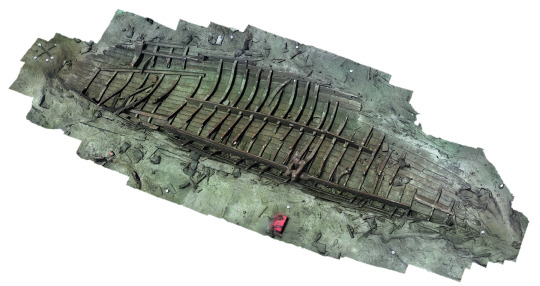#wismar wreck
Explore tagged Tumblr posts
Text
The Wismar Wreck
In 2017, archaeologists led by Jens Auer of the Mecklenburg-Western Pomerania State Office for the Preservation of Monuments discovered three wrecks from the early Hanseatic period in the harbor entrance of Wismar.

The Wismar wreck in 3-D scan on the bottom of Wismar Bay (x)
The third wreck is a sensation because it lay under the two others and is about 26m long and 8m wide. It was built in clinker technique and maybe it was not used for a long time.The ship was built around 1184 in Halland, in what is now southern Sweden, then part of Denmark. At the time of Danish King Waldemar II, there was a peaceful period with flourishing maritime trade. Grain, amber, goods from all over Europe, the Near East and even Persia were traded. The Wismar Wreck is a witness to this time and is even older than the city itself. It is believed that it was once a transport or merchant vessel that had a hole that they tried to repair before the ship sank off Wismar.
Since 2018 the wreck is now in Brede near Copenhagen to be processed and preserved.
The conservation process consists of two steps. First, the oak wood is impregnated with a polyethylene-glycol-water mixture and then freeze-dried. The polyethylene glycol serves as a substitute for the missing cellulose in the wood and protects the planks from cracking and deformation. All the individual parts of the wreck are placed on a kind of "sheet" that is pushed into the circular freeze dryer. The conservators around Jan Bruun Jensen make sure that the heaviest timbers are at the end, where it is easiest to reach. Some timbers weigh more than 100 kilograms. They remain in the freeze dryer for three to four months. And because there are 300 individual parts, the process is very time-consuming. Afterwards, it will return to Wismar to be exhibited there.
#naval history#naval artifacts#wreck#wismar wreck#medieval seafaring#12th century#sweden#denmark#germany
40 notes
·
View notes